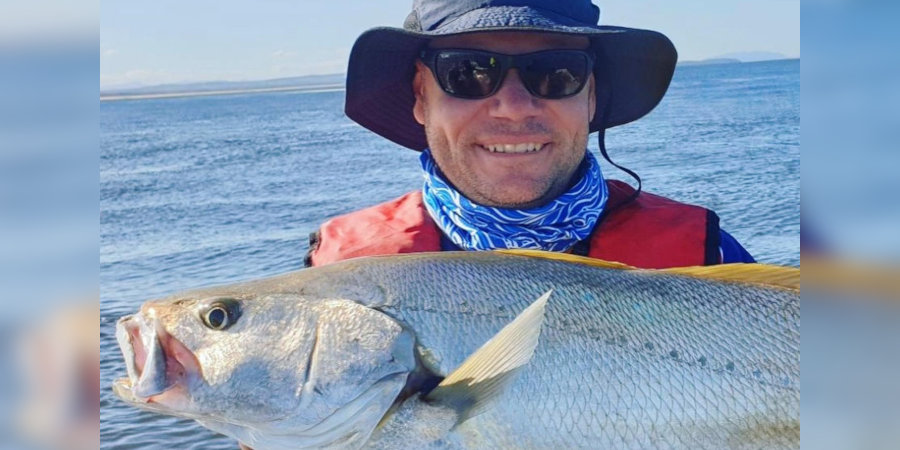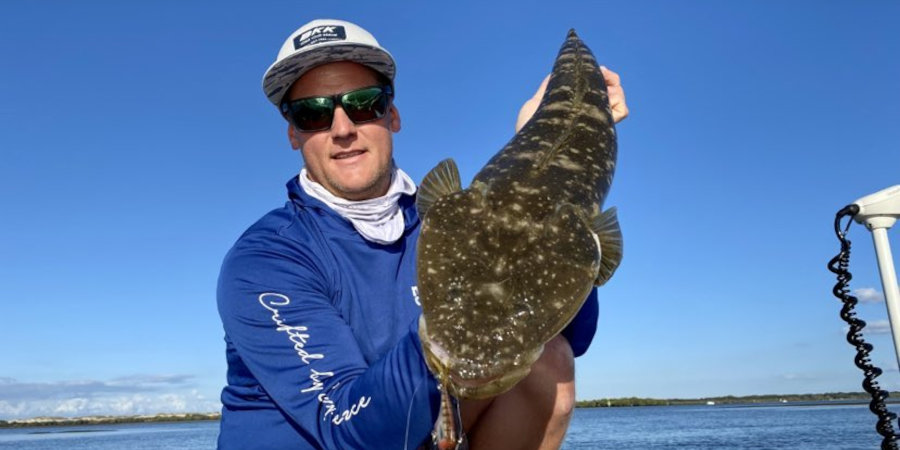This is ALF EPISODE #653 Check out Crossy’s previous episode, or our flathead fishing archive for more!

Welcome to a comprehensive exploration of topwater flathead fishing techniques with Simon Cross of Crossfire Lures fame. This detailed review captures Simon’s advanced tactics and insights, giving you a depth of knowledge that will take your topwater flathead fishing to new levels.
The Appeal of Flathead Fishing With Crossfire Lures
The Thrill of Topwater Lures
Topwater lures, like the Crossfire 110, are particularly effective because they mimic the movements of wounded baitfish at the water’s surface. This action is highly attractive to flathead, triggering their instinct to target weakened prey. Topwater fishing tends to result in the capture of a better class of fish, especially when larger lures such as the Crossfire 190 are deployed.
Insights from Flathead Fishing Competitions
Simon’s Crossfire Lures are a great asset in competitions because they closely replicate the movements of baitfish in ways that resonate with feeding flathead. At a recent competition in Mallacoota, using the Crossfire 110 was crucial for mimicking the local mullet, which is especially effective under clear water conditions.
Tackling Techniques: Maximizing Your Success
Gear Selection For Casting Crossfire Lures
Rods and Reels:
Simon recommends using medium-heavy rods combined with durable reels that have a robust drag system. This setup is essential for controlling the intense action during a flathead strike. He uses a St Croix rod, but the Jabbers Wanderlust is another great tool for targeting topwater flathead using Crossfire Lures.
Line and Leader Choices:
20-pound braided lines have minimal stretch and excellent power transfer, essential for keeping the topwater lures like the Crossfire 110 effectively in motion without sinking. In clear water, the use of fluorocarbon leaders is crucial for their low visibility and high abrasion resistance. The raspy teeth of a flathead can abrade through a leader fairly quickly – especially if the lure is inhaled well down.
Advanced Casting and Retrieval Techniques For Crossfire Lures
Simon emphasizes that mastering lure retrieval techniques, such as the ‘walk the dog’ style, is key to successful flathead fishing. Using this technique crossfire lures bent minnows simulate an injured fish at the water’s surface, an irresistible target for flathead. Experimenting with different ways of weighting the lure to make it dive deeper or stay below the surface slightly longer will often yield results.
Comprehensive Guide to Spotting Prime Fishing Locations
Reading the Water
Identifying signs of flathead or preferred habitats and structure, is critical. Signs that Simon specifically discussed include:
- Nipper Holes and Disturbed Sand: These are often tell-tale signs of flathead activity. Banks covered in nipper holes tend to attract whiting, mullet and other species that flathead prey on.
- Striations on the Sand: Simon mentions looking for variations in the sand patterns, where darker sand layers might indicate deeper areas that flathead prefer for ambushing prey.
- Water Temperature and Clarity: These environmental factors also play a significant role in flathead behaviour. Warmer waters can sometimes indicate more active fish, and clear water requires more stealthy lure presentation.
Understanding Flathead Behaviour
Crossy provided extensive insights into flathead behaviour, focusing on how they interact with their environment to optimize their hunting efficiency:
- Ambush Tactics: Flathead often use underwater structures and subtle terrain variations to ambush prey. Simon notes that they prefer areas where they can stay hidden but still have clear access to passing fish.
- Reactive to Environment: Changes in water clarity and temperature can significantly affect flathead behaviour. Flathead might become more or less active depending on these conditions, and adapt their hunting strategies accordingly.
- Use of Natural Cover: Flathead are known to use sandbanks, weed beds, and other natural covers to conceal themselves. Simon describes how these fish position themselves for optimal stealth and efficiency in attacking prey.
- Behavioural Patterns: Flathead have a preference for certain types of structure depending on the time of day and water conditions. Crossy emphasises the importance of understanding these patterns for successful fishing.
Conclusion: Mastering Topwater Flathead On Crossfire Lures
Simon and Andrew highlight the importance of adaptability and continuous learning in fishing. Adjusting techniques based on direct observations and being flexible in approach are vital for mastering the art of flathead fishing with Crossfire Lures.
 Simon Cross
Simon Cross
Topwater Flathead Guru and Lure Maker
In recent years Crossy has become something of a legend as a pioneer of topwater flathead fishing and the creator of one of the best surface lures for lizard luring – Crossfire Lures. Crossy’s understanding of flathead and how they hunt is second to none!

Fishing At Forster: 5 Top Spots With Local Gun Luke Austin
The fishing at Forster – Tuncurry is superb, all year round with numerous options for land-based and boating anglers alike. Luke Austin has lived there all his life and shares some great spots for visiting anglers and locals alike.

Fishing At Sussex Inlet: Cracking Flathead On Topwater With Nathan Bilsborough
This is ALF EPISODE 669. Want more? Check out nearby fishing spots, or other flathead fishing episodesIntroduction To Fishing At Sussex Inlet Welcome back, ALF listeners! Today, we’re diving deep into flathead fishing at Sussex Inlet, with expert insights from Nathan...

Forster Flathead Fishing With Russell Babekuhl
Russell Babekuhl has a very different take n fishing for the humble flathead, turning it into a fast current, white knuckle affair!

Mastering the Art of Flathead Fishing: Exploring The Waters of Jumpinpin
Hitting the Jumpinpin area over the summer months in search of quality flathead? Capn’s Charters guide Bo Sawyer explains everything you need to know.

Mastering Gold Coast Flathead With Guy McConnell
Flathead are distributed right across the Gold Coast in good numbers, but spring is the time when the bigger fish become more concentrated and easier to target. Gold Coast sponsored angler Guy McConnell does a great job of sharing tips that will help anyone catch more (and better quality) flathead on lures.

Fishing At Forster: 5 Top Spots With Local Gun Luke Austin
The fishing at Forster – Tuncurry is superb, all year round with numerous options for land-based and boating anglers alike. Luke Austin has lived there all his life and shares some great spots for visiting anglers and locals alike.

Fishing At Sussex Inlet: Cracking Flathead On Topwater With Nathan Bilsborough
This is ALF EPISODE 669. Want more? Check out nearby fishing spots, or other flathead fishing episodesIntroduction To Fishing At Sussex Inlet Welcome back, ALF listeners! Today, we’re diving deep into flathead fishing at Sussex Inlet, with expert insights from Nathan...

 Simon Cross
Simon Cross
0 Comments